Abstract
In female mammals, one of the two X chromosomes present is inactivated during early development. In marsupials, the paternal X is inactivated; in eutherians, one of the two X chromosomes is inactivated at random. A mechanism is proposed to explain the cytogenetic data on inactivation and the derivation of the eutherian system from the marsupial system. In the marsupial system, a site on the X chromosome is sensitive to paternal origin: when the X chromosome is of maternal origin, this sensitive site is responsible for influencing an adjacent site, the receptor, to maintain the X in an active state; the paternal X becomes inactive. Transposition of the sensitive site to an autosome in eutherians would have two consequences. Since the receptor site of the X chromosome is no longer adjacent, the autosomal sensitive site of maternal origin would activate an X at random. The number of active X chromosomes would conform to the number of maternal sensitive sites and thus, generally, to the number of maternal sets of autosomes. The response of the sensitive site to its passage through the male may be designated as imprinting, a term used by Crouse to indicate that the behavior of Sciara chromosomes is determined by parental origin.
Keywords: Lyon hypothesis, heterochromatin, genetic regulation, sex chromatin
Full text
PDF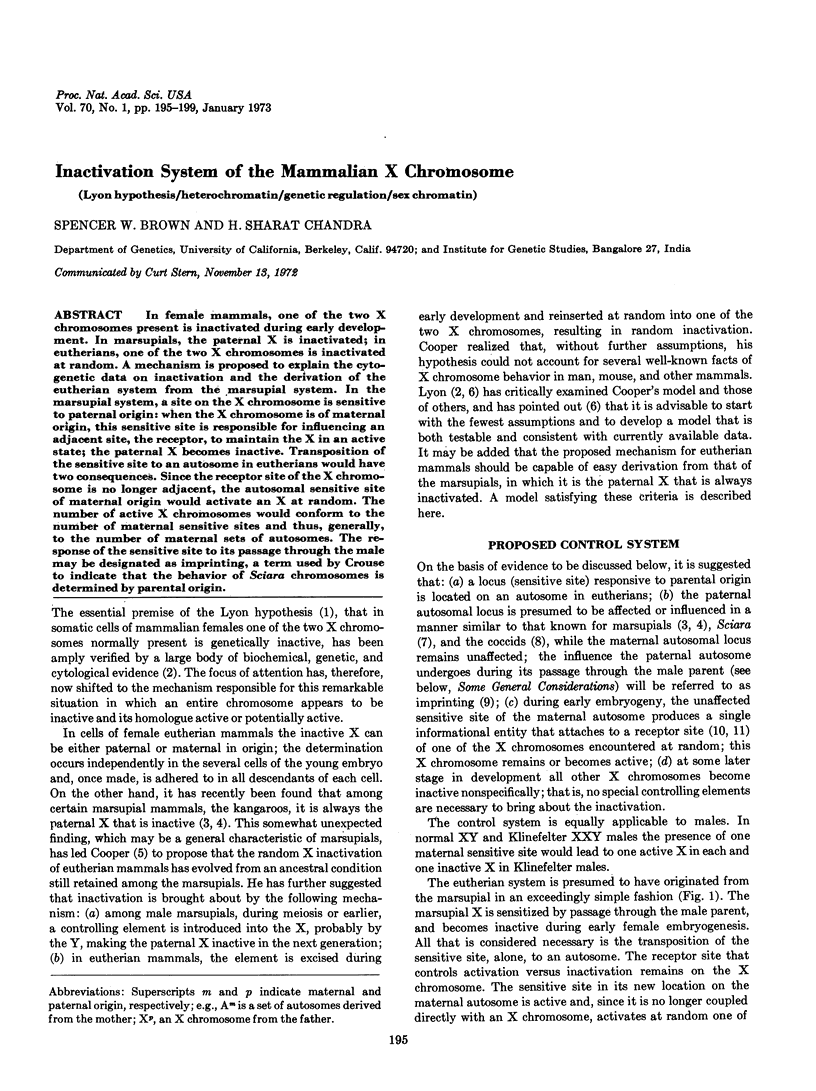
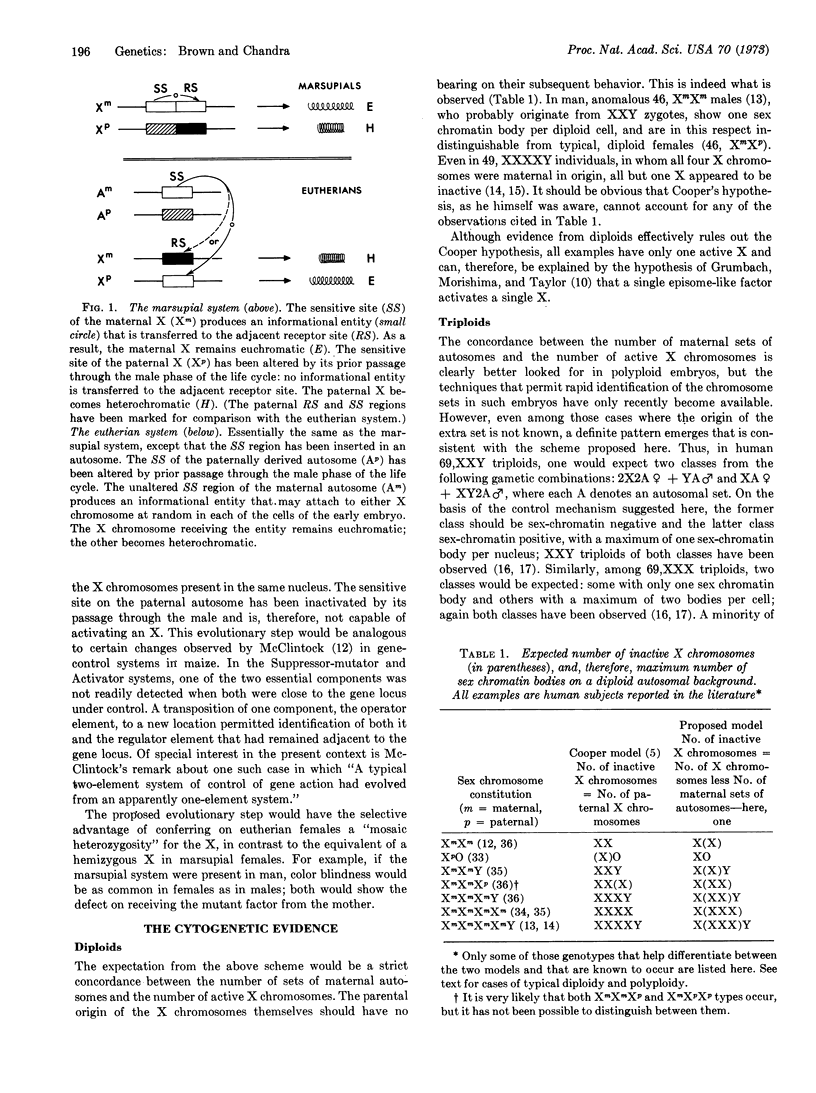
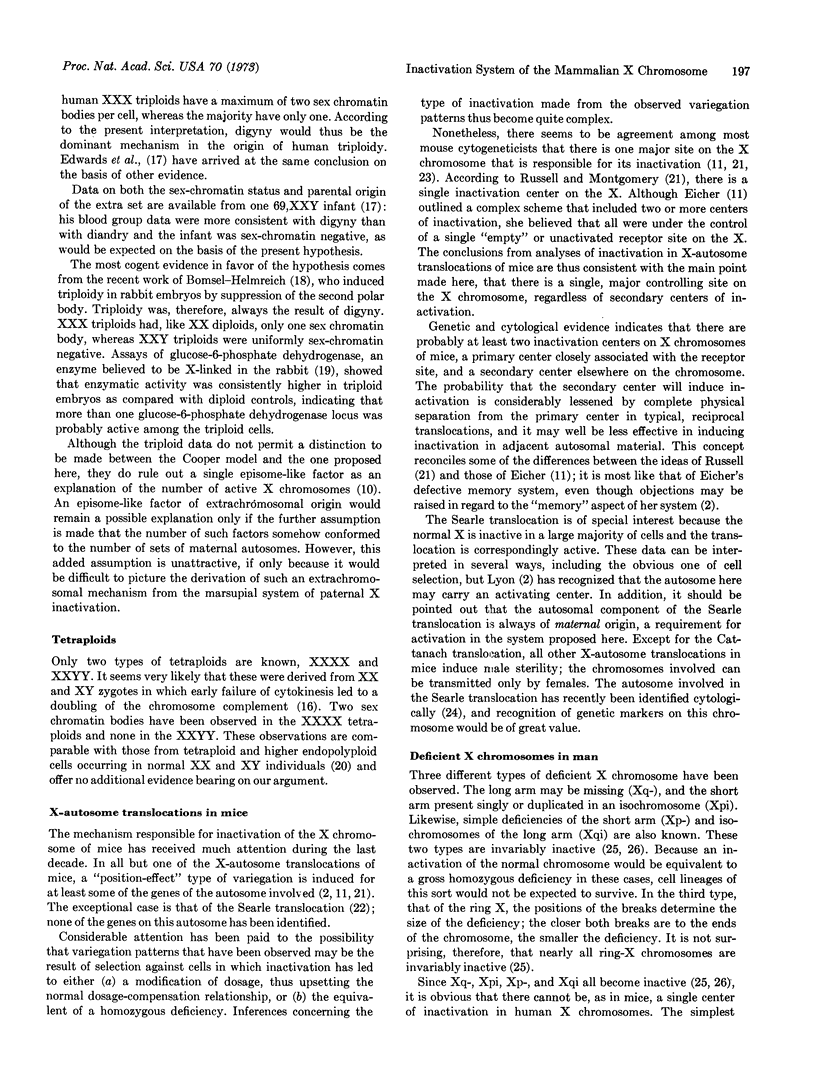
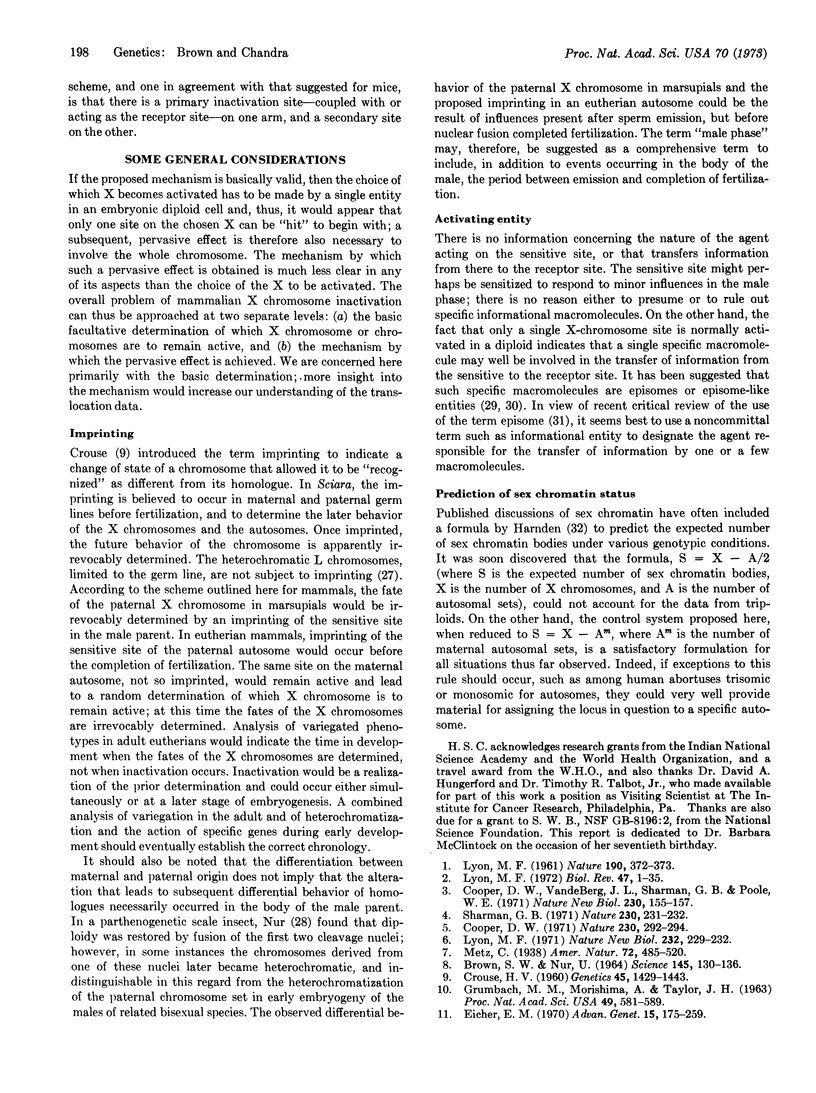
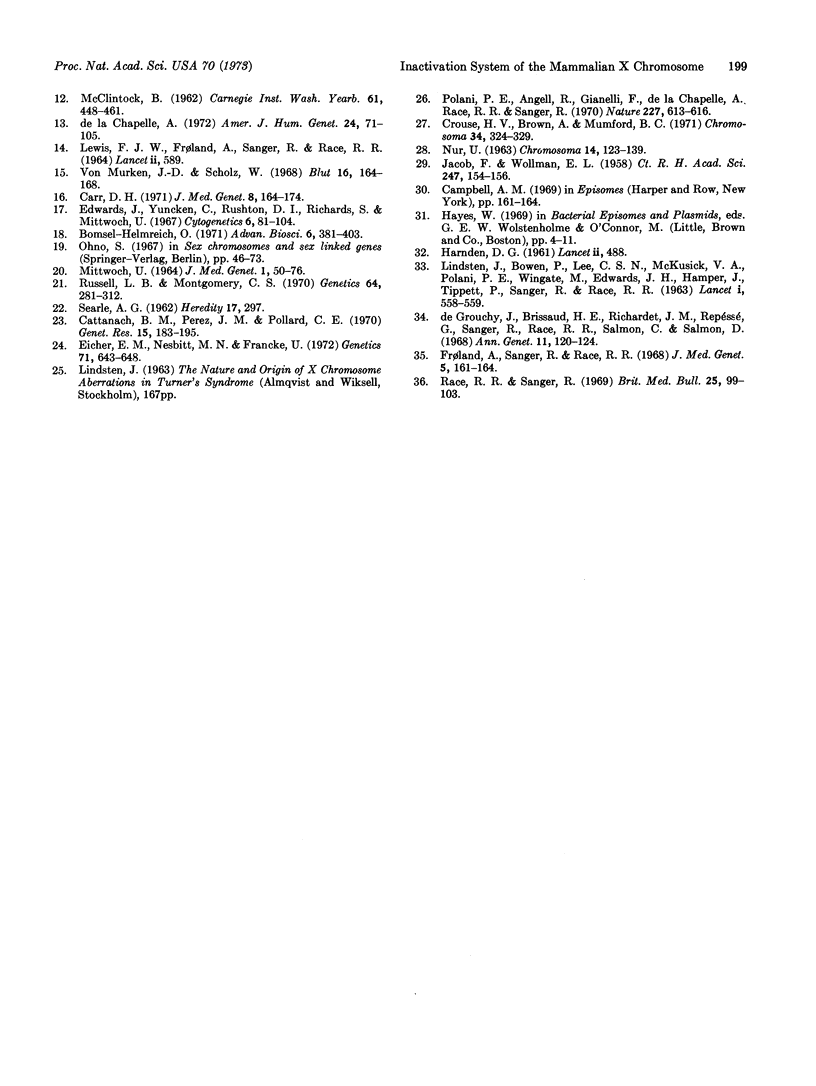
Selected References
These references are in PubMed. This may not be the complete list of references from this article.
- BROWN S. W., NUR U. HETEROCHROMATIC CHROMOSOMES IN THE COCCIDS. Science. 1964 Jul 10;145(3628):130–136. doi: 10.1126/science.145.3628.130. [DOI] [PubMed] [Google Scholar]
- Carr D. H. Chromosome studies in selected spontaneous abortions. Polyploidy in man. J Med Genet. 1971 Jun;8(2):164–174. doi: 10.1136/jmg.8.2.164. [DOI] [PMC free article] [PubMed] [Google Scholar]
- Cattanach B. M., Perez J. N., Pollard C. E. Controlling elements in the mouse X-chromosome. II. Location in the linkage map. Genet Res. 1970 Apr;15(2):183–195. doi: 10.1017/s0016672300001518. [DOI] [PubMed] [Google Scholar]
- Cooper D. W. Directed genetic change model for X chromosome inactivation in eutherian mammals. Nature. 1971 Apr 2;230(5292):292–294. doi: 10.1038/230292a0. [DOI] [PubMed] [Google Scholar]
- Cooper D. W., VandeBerg J. L., Sharman G. B., Poole W. E. Phosphoglycerate kinase polymorphism in kangaroos provides further evidence for paternal X inactivation. Nat New Biol. 1971 Mar 31;230(13):155–157. doi: 10.1038/newbio230155a0. [DOI] [PubMed] [Google Scholar]
- Crouse H V. The Controlling Element in Sex Chromosome Behavior in Sciara. Genetics. 1960 Oct;45(10):1429–1443. doi: 10.1093/genetics/45.10.1429. [DOI] [PMC free article] [PubMed] [Google Scholar]
- Crouse H. V., Brown A., Mumford B. C. --chromosome inheritance and the porblem of chromosome "imprinting" in Sciara (Sciaridae, Diptera). Chromosoma. 1971;34(3):324–8. doi: 10.1007/BF00286156. [DOI] [PubMed] [Google Scholar]
- Edwards J. H., Yuncken C., Rushton D. I., Richards S., Mittwoch U. Three cases of triploidy in man. Cytogenetics. 1967;6(2):81–104. doi: 10.1159/000129932. [DOI] [PubMed] [Google Scholar]
- Eicher E. M., Nesbitt M. N., Francke U. Cytological identification of the chromosomes involved in Searle's translocation and the location of the centromere in the X chromosome of the mouse. Genetics. 1972 Aug;71(4):643–648. doi: 10.1093/genetics/71.4.643. [DOI] [PMC free article] [PubMed] [Google Scholar]
- Froland A., Sanger R., Race R. R. Xg blood groups of 78 patients with Klinefelter's syndrome and of some of their parents. J Med Genet. 1968 Sep;5(3):161–164. doi: 10.1136/jmg.5.3.161. [DOI] [PMC free article] [PubMed] [Google Scholar]
- Grumbach M. M., Morishima A., Taylor J. H. HUMAN SEX CHROMOSOME ABNORMALITIES IN RELATION TO DNA REPLICATION AND HETEROCHROMATINIZATION. Proc Natl Acad Sci U S A. 1963 May;49(5):581–589. doi: 10.1073/pnas.49.5.581. [DOI] [PMC free article] [PubMed] [Google Scholar]
- JACOB F., WOLLMAN E. L. Les épisomes, éléments génétiques ajoutés. C R Hebd Seances Acad Sci. 1958 Jul 7;247(1):154–156. [PubMed] [Google Scholar]
- LEWIS F. J., FROLAND A., SANGER R., RACE R. R. SOURCE OF THE X CHROMOSOMES IN TWO XXXXY MALES. Lancet. 1964 Sep 12;2(7359):589–589. doi: 10.1016/s0140-6736(64)90658-0. [DOI] [PubMed] [Google Scholar]
- LINDSTEN J. Source of the X in XO females: the evidence of Xg. Lancet. 1963 Mar 9;1(7280):558–559. doi: 10.1016/s0140-6736(63)91367-9. [DOI] [PubMed] [Google Scholar]
- LYON M. F. Gene action in the X-chromosome of the mouse (Mus musculus L.). Nature. 1961 Apr 22;190:372–373. doi: 10.1038/190372a0. [DOI] [PubMed] [Google Scholar]
- Lyon M. F. Possible mechanisms of X chromosome inactivation. Nat New Biol. 1971 Aug 25;232(34):229–232. doi: 10.1038/newbio232229a0. [DOI] [PubMed] [Google Scholar]
- Lyon M. F. X-chromosome inactivation and developmental patterns in mammals. Biol Rev Camb Philos Soc. 1972 Jan;47(1):1–35. doi: 10.1111/j.1469-185x.1972.tb00969.x. [DOI] [PubMed] [Google Scholar]
- MITTWOCH U. SEX CHROMATIN. J Med Genet. 1964 Sep;1(1):50–76. doi: 10.1136/jmg.1.1.50. [DOI] [PMC free article] [PubMed] [Google Scholar]
- Murken J. D., Scholz W. Serologische Klärung der Herkunft der überzähligen X-Chromosomen beim XXXXY-Syndrom. Blut. 1967 Dec;16(3):164–168. doi: 10.1007/BF01630886. [DOI] [PubMed] [Google Scholar]
- Polani P. E., Angell R., Giannelli F., De la Chapelle A., Race R. R., Sanger R. Evidence that the Xg locus is inactivated in structurally abnormal X chromosomes. Nature. 1970 Aug 8;227(5258):613–616. doi: 10.1038/227613a0. [DOI] [PubMed] [Google Scholar]
- Race R. R., Sanger R. Xg and sex-chromosome abnormalities. Br Med Bull. 1969 Jan;25(1):99–103. doi: 10.1093/oxfordjournals.bmb.a070677. [DOI] [PubMed] [Google Scholar]
- Russell L. B., Montgomery C. S. Comparative studies on X-autosome translocations in the mouse. II. Inactivation of autosomal loci, segregation, and mapping of autosomal breakpoints in five T (X;1) S. Genetics. 1970 Feb;64(2):281–312. doi: 10.1093/genetics/64.2.281. [DOI] [PMC free article] [PubMed] [Google Scholar]
- Sharman G. B. Late DNA replication in the paternally derived X chromosome of female kangaroos. Nature. 1971 Mar 26;230(5291):231–232. doi: 10.1038/230231a0. [DOI] [PubMed] [Google Scholar]
- de Grouchy J., Brissaud H. E., Richardet J. M., Repéssé G., Sanger R., Race R. R., Salmon C., Salmon D. Syndrome 48, XXXX chez une enfant de six ans. Transmission anormale du gourpe Xg. Ann Genet. 1968 Jun;11(2):120–124. [PubMed] [Google Scholar]
- de la Chapelle A. Analytic review: nature and origin of males with XX sex chromosomes. Am J Hum Genet. 1972 Jan;24(1):71–105. [PMC free article] [PubMed] [Google Scholar]


